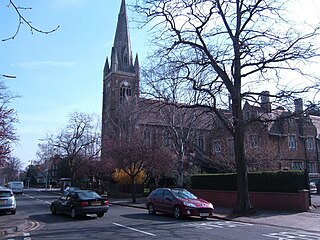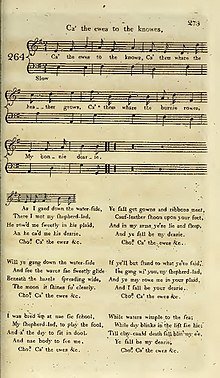
The War Requiem, Op. 66, is a choral and orchestral composition by Benjamin Britten, composed mostly in 1961 and completed in January 1962. The War Requiem was performed for the consecration of the new Coventry Cathedral, in the English county of Warwickshire, which was built after the original fourteenth-century structure was destroyed in a World War II bombing raid. The traditional Latin texts are interspersed, in telling juxtaposition, with extra-liturgical poems by Wilfred Owen, written during World War I.

"Auld Lang Syne" is a Scottish song. In the English-speaking world, it is traditionally sung to bid farewell to the old year at the stroke of midnight on Hogmanay/New Year's Eve. It is also often heard at funerals, graduations, and as a farewell or ending to other occasions; for instance, many branches of the Scouting movement use it to close jamborees and other functions.

Saint Cecilia, also spelled Cecelia, was a Roman Christian virgin martyr, who is venerated in Catholic, Orthodox, Anglican, and some Lutheran churches, such as the Church of Sweden. She became the patroness of music and musicians, it being written that, as the musicians played at her wedding, Cecilia "sang in her heart to the Lord". Musical compositions are dedicated to her, and her feast, on 22 November, is the occasion of concerts and musical festivals. She is also known as Cecilia of Rome.

David Conte is an American composer who has written over 150 works published by E.C. Schirmer, including six operas, a musical, works for chorus, solo voice, orchestra, chamber music, organ, piano, guitar, and harp. Conte has received commissions from Chanticleer, the San Francisco Symphony Chorus, Harvard University Chorus, the Men’s Glee Clubs of Cornell University and the University of Notre Dame, GALA Choruses from the cities of San Francisco, New York, Boston, Atlanta, Seattle, and Washington, D.C., the Dayton Philharmonic, the Oakland Symphony, the Stockton Symphony, the Atlantic Classical Orchestra, the American Guild of Organists, Sonoma City Opera, and the Gerbode Foundation. He was honored with the American Choral Directors Association (ACDA) Brock Commission in 2007 for his work The Nine Muses, and in 2016 he won the National Association of Teachers of Singing (NATS) Art Song Composition Award for his work American Death Ballads.
"Foggy Dew" or "Foggy, Foggy Dew" is an English folk song with a strong presence in the South of England and the Southern United States in the nineteenth century. The song describes the outcome of an affair between a weaver and a girl he courted. It is cataloged as Laws No. O03 and Roud Folk Song Index No. 558. It has been recorded by many traditional singers including Harry Cox, and a diverse range of musicians including Benjamin Britten, Burl Ives, A.L. Lloyd and Ye Vagabonds have arranged and recorded popular versions of the song.
"Ariel's song" is a verse passage in Scene ii of Act I of William Shakespeare's The Tempest. It consists of two stanzas to be delivered by the spirit Ariel, in the hearing of Ferdinand. In performance it is sometimes sung and sometimes spoken. There is an extant musical setting of the second stanza by Shakespeare's contemporary Robert Johnson, which may have been used in the original production around 1611.

Isabel Pagan, also known as "Tibbie", was a Scottish poet of the Romantic Era.

Spring Symphony is a choral symphony by Benjamin Britten, his Opus 44. The work is scored for soprano, alto and tenor soloists, mixed choir, boys' choir and orchestra. Britten used texts of several poems related to spring, mostly from the 16th and 17th centuries and also one by W. H. Auden. Britten dedicated the work to Serge Koussevitzky and the Boston Symphony Orchestra. The work received its premiere in the Concertgebouw, Amsterdam on 14 July 1949 as part of the Holland Festival
The Corpus Christi Carol or Falcon Carol is a Middle or Early Modern English hymn, first written down by an apprentice grocer named Richard Hill between 1504 and 1536. The original writer of the carol remains anonymous. The earliest surviving record of the piece preserves only the lyrics and is untitled. It has survived in altered form in the folk tradition as the Christmas carol "Down In Yon Forest". The structure of the carol is six stanzas, each with rhyming couplets. The tense changes in the fourth stanza from past to present continuous.

Rejoice in the Lamb is a cantata for four soloists, SATB choir and organ composed by Benjamin Britten in 1943 and uses text from the poem Jubilate Agno by Christopher Smart (1722–1771). The poem, written while Smart was in an asylum, depicts idiosyncratic praise and worship of God by different things including animals, letters of the alphabet and musical instruments. Britten was introduced to the poem by W. H. Auden whilst visiting the United States, selecting 48 lines of the poem to set to music with the assistance of Edward Sackville-West. The cantata was commissioned by the Reverend Walter Hussey for the celebration of the 50th anniversary of the consecration of St Matthew's Church, Northampton. Critics praised the work for its uniqueness and creative handling of the text. Rejoice in the Lamb has been arranged for chorus, solos and orchestral accompaniment, and for SSAA choir and organ.
Patrick Arthur Sheldon Hadley was a British composer.

Hodie is a cantata by Ralph Vaughan Williams. Composed between 1953 and 1954, it is the composer's last major choral-orchestral composition, and was premiered under his baton at Worcester Cathedral, as part of the Three Choirs Festival, on 8 September 1954. The piece is dedicated to Herbert Howells. The cantata, in 16 movements, is scored for chorus, boys' choir, organ and orchestra, and features tenor, baritone, and soprano soloists.

"The Shepherd" is a poem from William Blake's Songs of Innocence (1789). This collection of songs was published individually four times before it was combined with the Songs of Experience for 12 editions which created the joint collection Songs of Innocence and of Experience (1794). Blake produced all of the illuminated printings himself beginning in 1789. Each publication of the songs has the plates in a different order, and sixteen other plates were published posthumously.
The Choral Symphony is a work by Gustav Holst for soprano soloist, chorus, and orchestra in a setting of verses by John Keats. Written in 1923–24, it was premiered in Leeds Town Hall on October 7, 1925, conducted by Albert Coates with Dorothy Silk as soloist. The same performers gave the work's second performance three weeks later in Queen's Hall, London. The work is sometimes known as the First Choral Symphony, although a planned 'second Choral Symphony' never progressed beyond some uncompleted sketches.
"Comin' Thro' the Rye" is a poem written in 1784 by Robert Burns (1759–1796). The words are put to the melody of the Scottish Minstrel "Common' Frae The Town". This is a variant of the tune to which "Auld Lang Syne" is usually sung—the melodic shape is almost identical, the difference lying in the tempo and rhythm.
Roderick Gregory Coleman Williams OBE is a British baritone and composer.

"Music, When Soft Voices Die" is a major poem by Percy Bysshe Shelley, written in 1821 and first published in Posthumous Poems of Percy Bysshe Shelley in 1824 in London by John and Henry L. Hunt with a preface by Mary Shelley. The poem is one of the most anthologised, influential, and well-known of Shelley's works.
Charles Clement Fussell is an American composer and conductor of contemporary classical music. He has composed six symphonies and three operas. His symphony Wilde for solo baritone and orchestra, based on the life of Oscar Wilde and premiered by the Newton Symphony Orchestra and the baritone Sanford Sylvan in 1990, was a finalist for the 1991 Pulitzer Prize for Music. He received a citation and award from the American Academy of Arts and Letters in 1992.
Five Tudor Portraits (1935), by Ralph Vaughan Williams, is a work scored for contralto, baritone, mixed chorus and orchestra. It sets several poems, or extracts from poems, by the 15th/16th-century poet John Skelton, portraying five characters with a mixture of satire, compassion, acerbity and earthy humour. Though acclaimed by critics, it has not been so frequently performed as some of Vaughan Williams' other works. In its complete form it lasts about 42 minutes, though the composer also sanctioned the performance of individual movements separately.














